|
Introduction to Chinese Opera
1 | The Development of Chinese Opera |
Chinese opera is a type of art performance that combines script, music, dance, martial arts and art together. Its origin can be traced back to the pre-Qin Dynasty times. It then developed into a more mature form until Yun, Ming and Qing Dynasties. By that time, it had more complete singing forms, and became popular among the public and even people in the upper class.

• “Nan Zhong Fan Hui Tu (南中繁會圖)” of Ming Dynasty. It portraits the scene of setting up a stage for performance in a village
Basic characters of Chinese opera includes sheng (生), dan (旦), jing (淨) and chou (丑).
| Sheng |
Male characters. It includes wusheng (武生), xiaosheng (小生) and laosheng (老生), etc. |
| Dan |
Female characters. It includes zhengdan (正旦), wudan (武旦), huadan (花旦) and laodan (老旦), etc. |
| Jing |
It is also known as “hualian (花臉)” because of its exaggerated makeup. It is a type of male characters which may have unique personalities, qualities and facial appearance. |
| Chou |
It is a kind of comic role, also known as “xiaohualian (小花臉)”. It usually puts white powder on the bridge of the nose. It portraits many kind of characters such as kind, humorous and wicked people. |
Music of Chinese opera can be divided into two parts: vocal music and instrumental music. Vocal music is used to deliver the story and portrait characters while instrumental music is used to accompany and create different moods to build up the story.
Characteristics of vocal music
of Chinese opera |
Characteristics of instrumental music
of Chinese opera |
- Changqiang (唱腔)
- Refers to the singing
- It can be solo, duet and chorus
- Nianbai (唸白)
- Refers to the speeches
- It can be speeches of yunwen (韻文) or sanbai (散白) of colloquial style
|
- Winds and strings
- It mainly consists of Chinese string and wind instruments
- It is mainly for accompanying the singing part
- Percussions
- It creates different effects with percussion instruments
- In some kinds of Chinese operas, such as Cantonese opera, it takes the role of creating emotions and moods
|
Chinese Local Opera
[ Back to top ]
Beijing opera is also known as “Pingju (平劇)” and “Guoju (國劇)”. It has around 200 years of history. It is one of the most important type of opera among Chinese operas. Some characters may put on masks, which is a characteristics of Beijing opera.
Style and characteristics of Beijing opera:
| Changqiang |
• It mainly includes erhuang (二黃) and xipi (西皮) of banqiang style (板腔體).
Expressive
songs are usually sung in slow
tempo with fewer words and more singing
techniques.
• Descriptive songs are usually
sung in fast tempo with more words and less
singing
techniques.
|
| Instruments |
Luogu is used throughout the opera. Percussion instruments such as naoba (鐃鈸), qiba (齊鈸), zhuangzhong (撞鐘), yunluo, bangzi are also used. Wind and string instruments include jinghu (京胡), dizi, erhu, yueqin, xuanzi (弦子), sheng, suona and haidi (海笛), etc. |
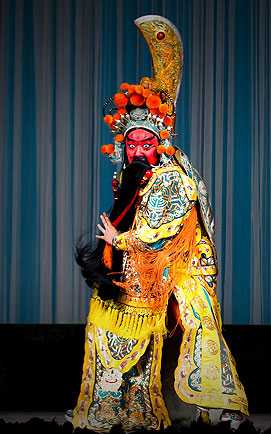 • An actor who portraits Guanyu (關羽) in a Beijing opera. He has red face paint design on his face |
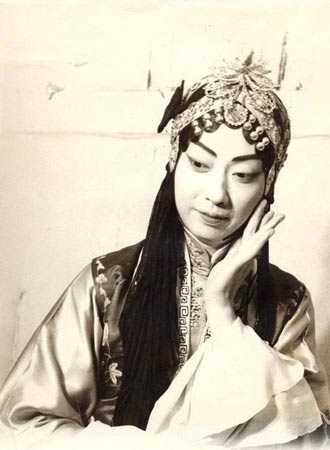 • Mei Lan-fang (1894-1961), who is known as one of the Four Great Dan |
[ Back to top ]
Kun opera is also called Kunqu. It is popular in Jiangsu and has around 500 years of history. It is one of the oldest and most influential Chinese opera. One of the characteristics of Kun opera is to borrow features of animals to portrait the personalities of characters.
Style and characteristics of Kun opera:
| Changqiang |
• Its music belongs to qupai style (曲牌體).
• It uses shuimo tune (水磨調), which is fine and soft, to sing.
|
| Instruments |
Qudi is the main instrument. Wind and string instruments also includes xiao, suona, sheng, pipa, sanxian and yueqin. Percussion instruments include guban, daluo, xiaoluo and tanggu (堂鼓). |
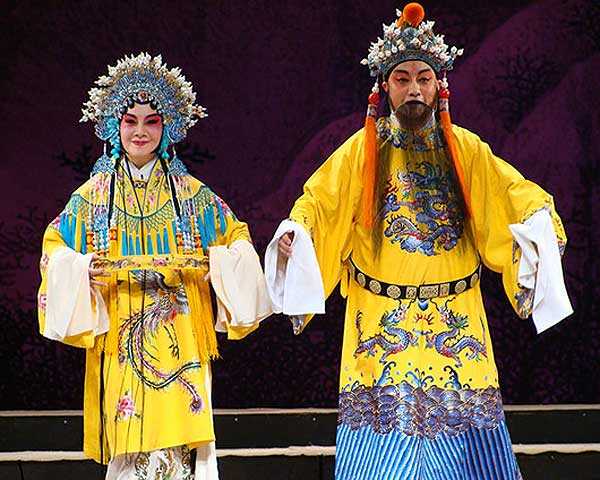
• Stage performance of Kun opera “The Palace of Eternal Life (長生殿)”
Cantonese opera is a major type of Chinese opera in Southern China. It is sung in Cantonese and is popular in Guangdong and Hong Kong. Cantonese opera focuses on singing techniques.
Style and characteristics of Cantonese opera:
| Changqiang |
• Its music is mainly bangzi and erhuang of banqiang style. Qupai style is also used.
• Changqiang can be divided into pinghou,
zihou and dahou. Pinghou uses real voice and
is mainly used by sheng. Zihou uses falsetto
and is mainly used by dan. Dahou produces
loud and emotional sounds and is mainly used by wusheng.
|
| Instruments |
Wind and string instruments include gaohu, erxian and yangqin. Percussion instruments include buyu, gaobiangu (高邊鼓), shagu (沙鼓) and daba.
|
| Characters |
Characters are originally classified as “Shi Da Hang Dang (十大行當)”. “Liuzhuzhi (六柱制)” was developed in the 1930s. |
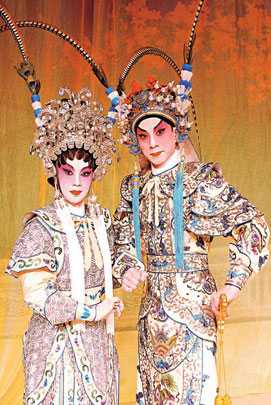 • The look of a character in Cantonese opera |
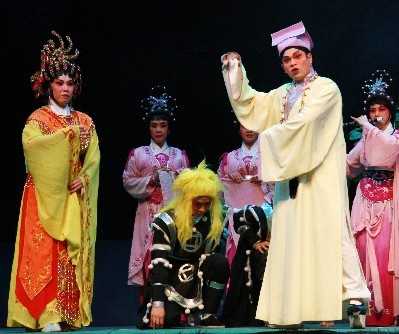 • Stage performance of a Cantonese opera |
[ Back to top ]
Chaozhou opera refers to the opera that combines local tunes and operas from other places together. It is sung in the Teochew dialect (潮州話) and is popular in Chaozhou in the Guangdong province. It has the characteristics of Yi Chang Zhong He (一唱眾和) and bangqiang (幫腔).
Style and characteristics of Chaozhou opera:
| Changqiang |
It includes tuoqiang (拖腔) and bangqiang. Singing in tuoqiang means singing in melisma, which is to sing a syllable while moving between different notes. Bangqiang means a group of people singing the coda (尾聲) to support the soloist, or to sing descriptive songs in unison.
|
| Instruments |
Besides erhu, suona and muyu, special instruments such as erxian (二弦), yehu (椰胡), quluo (曲鑼), shenbo (深波) and haotou (號頭) are also used.
|
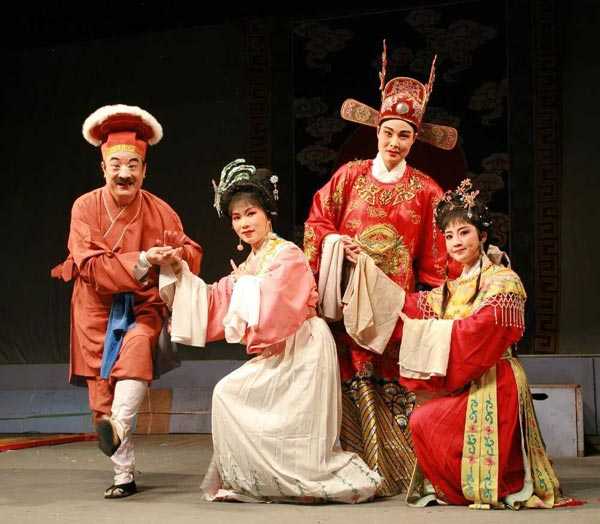
• Stage performance of a Chaozhou opera
|






